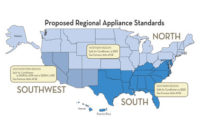New rules dictating energy usage in walk-in coolers and freezers (WICF) will become law Sept. 7, according to a recently published final rule, courtesy of the U.S. Department of Energy (DOE).
The energy conservation standards, which were published in the Federal Register on July 11, will set regulations for several classes of WICF refrigeration systems, including low-temperature dedicated condensing refrigeration systems and both medium- and low-temperature unit coolers.
The adopted standards, which are expressed in terms of annual walk-in energy factor (AWEF), are shown in Table 1. AWEF is an annualized refrigeration efficiency metric that expresses the ratio of the heat load that a system can reject (in Btu) to the energy required to reject that load (in watt-hours).
Per the DOE, the adopted WICF standards are projected to yield significant environmental benefits. Estimates state the standards will result in cumulative emission reductions (over the same period as for energy savings) of 46 million metric tons (Mt) of CO2, 36,000 tons of sulfur dioxide (SO2), and 58 tons of nitrogen oxides (NOx). The estimated cumulative reduction in CO2 emissions through 2030 amounts to 7.4 Mt, which is equivalent to the emissions resulting from the annual electricity use of more than 783,000 homes.
Relative to the case without adopting the standards, the lifetime energy savings for the considered WICF refrigeration systems purchased in the 30-year period that begins in the anticipated year of compliance with the standards (2020-2049) amount to 0.9 quadrillion Btu, which represents a 24 percent savings relative to the energy use of these products in the case without standards.
PROCESSES AND PROCEDURES
In June 2014, the DOE issued new standards for walk-ins that required separate minimum efficiency levels for panels, doors, and refrigeration systems. The rules proposed to reduce the cost to operate a refrigeration system for a walk-in cooler or freezer by 10-38 percent.
The regulations met resistance in the form of a lawsuit filed jointly by the Air-Conditioning, Heating, and Refrigeration Institute (AHRI) and Lennox Intl. Inc. on Aug. 4, 2014. The petitioners argued the DOE had made multiple errors when promulgating its final rule and had set standards that were neither technically feasible nor economically justifiable for manufacturers and installers. But, before AHRI and Lennox took the matter to the courts, they petitioned the DOE to reconsider its rule outside of court.
“They denied the petition, so we asked the court to challenge the denial and the underlying rule,” said Amy Shepherd, general counsel at AHRI, in a 2015 NEWS article. “We shared why we thought there were some errors.”
As part of the settlement agreement, the DOE withdrew six energy conservation standards — two of which are applicable to multiplex condensing refrigeration units operating at medium and low temperatures and four of which are applicable to dedicated condensing refrigeration units operating at low temperatures — and created a working group under the Appliance Standards and Rulemaking Federal Advisory Committee (ASRAC). The working group includes a variety of stakeholders who will develop new recommendations for the vacated standards.
“The key thing is that the ASRAC approve and recommended the standards to the DOE,” Shepherd said. “The working group submits it to ASRAC; then, they have a meeting to consider and hopefully approve the standards. They then make the recommendation to the DOE.”
The July 10, 2017, final rule was the result of a negotiated rulemaking that included refrigeration system manufacturers, installers, utilities, states, and energy-efficiency advocates.
Manufacturers will have three years from the publication date to comply, which sets the official compliance date at July 10, 2020.
“I believe the industry is well prepared to comply,” said Steve Combs, engineering manager, Everidge. “The ruling will no doubt lead to the development of new, cutting-edge technologies that will revolutionize the way we think about heat removal and cold storage in general. The consequences to the end user will be increased equipment costs; however, the payback periods should be nominal, based on aggregate data the industry provided.”
Barton James, senior vice president for government relations, ACCA, is not a fan of the regulations.
“Our members sell products available to them, and they want customers’ business, so we always have an eye toward that. Until they make changes from a regulatory standpoint, these are meaningless and sending the wrong message.”
Combs calls the final draft of the regulation a baseline ruling, at best.
“Having been directly involved in the development of this ruling and exposed to the development and deployment of other such rulings, I expect this to be subject to modification and revision as the DOE and industry interaction evolves,” Combs said. “Over the three-year period, I believe the DOE and the industry will uncover limitations not readily evident at this point as well as opportunities for improvement and more practical application of this and other energy conservation measures. In my opinion, any initiative that will increase efficiency, reduce environmental impact, and lead to collaborative development is a good thing. This ruling, along with future rulings and the desire of major manufacturers to be technological leaders, will hopefully induce new research and development across the refrigeration industry and revolutionize cold storage as we know it.”
Publication date: 8/28/2017
Want more HVAC industry news and information? Join The NEWS on Facebook, Twitter, and LinkedIn today!









